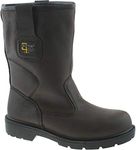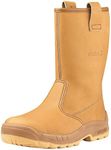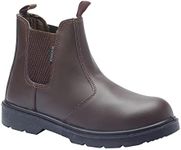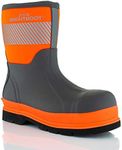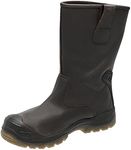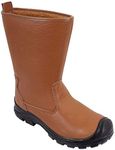Buying Guide for the Best Rigger Boots
Rigger boots are a type of pull-on safety boot that are popular in industries such as construction, oil, and gas due to their durability and ease of use. When choosing the right pair of rigger boots, it's important to consider the environment in which you'll be using them, the level of protection you need, and the comfort they provide. Understanding the key specifications will help you make an informed decision that ensures safety and comfort during your workday.MaterialThe material of rigger boots is crucial as it determines the durability, protection, and comfort of the boots. Common materials include leather, which is durable and offers good protection, and synthetic materials, which can be lighter and more flexible. If you work in wet conditions, look for waterproof materials or treatments. For those in environments with heavy machinery, a tougher material like leather might be more suitable. Consider the conditions you'll be working in to choose the right material for your needs.
Safety Toe CapThe safety toe cap is a protective reinforcement at the front of the boot that protects your toes from falling objects or compression. They can be made from steel, composite materials, or aluminum. Steel toe caps offer the highest level of protection but can be heavier, while composite toe caps are lighter and do not conduct electricity, making them suitable for electricians. Aluminum toe caps are lighter than steel but still provide good protection. Choose based on the level of protection you need and the weight you are comfortable with.
Sole MaterialThe sole material affects the grip, durability, and comfort of the rigger boots. Rubber soles are common and provide good slip resistance, which is important for wet or oily surfaces. PU (polyurethane) soles are lighter and offer good shock absorption, making them comfortable for long periods of standing or walking. Consider the surfaces you'll be working on and the level of comfort you need when choosing the sole material.
InsulationInsulation in rigger boots is important if you work in cold environments, as it helps keep your feet warm. Insulated boots have a layer of material that traps heat, while non-insulated boots are better for warmer climates. If you work outdoors in winter or in refrigerated environments, insulated boots can be a good choice. For indoor or hot weather work, non-insulated boots might be more comfortable.
WaterproofingWaterproofing is a key feature if you work in wet conditions, as it keeps your feet dry and comfortable. Some boots are made from waterproof materials, while others have a waterproof lining. If you frequently work in rain, mud, or waterlogged areas, waterproof boots are essential. If your work environment is mostly dry, this feature might be less critical.
Fit and ComfortFit and comfort are essential for any footwear, especially for work boots that you wear for long hours. A good fit prevents blisters and foot fatigue. Look for boots with a comfortable insole and adequate arch support. Some boots offer adjustable features like straps or elasticated sides for a better fit. Try on different sizes and styles to find the one that feels most comfortable for your foot shape and size.



